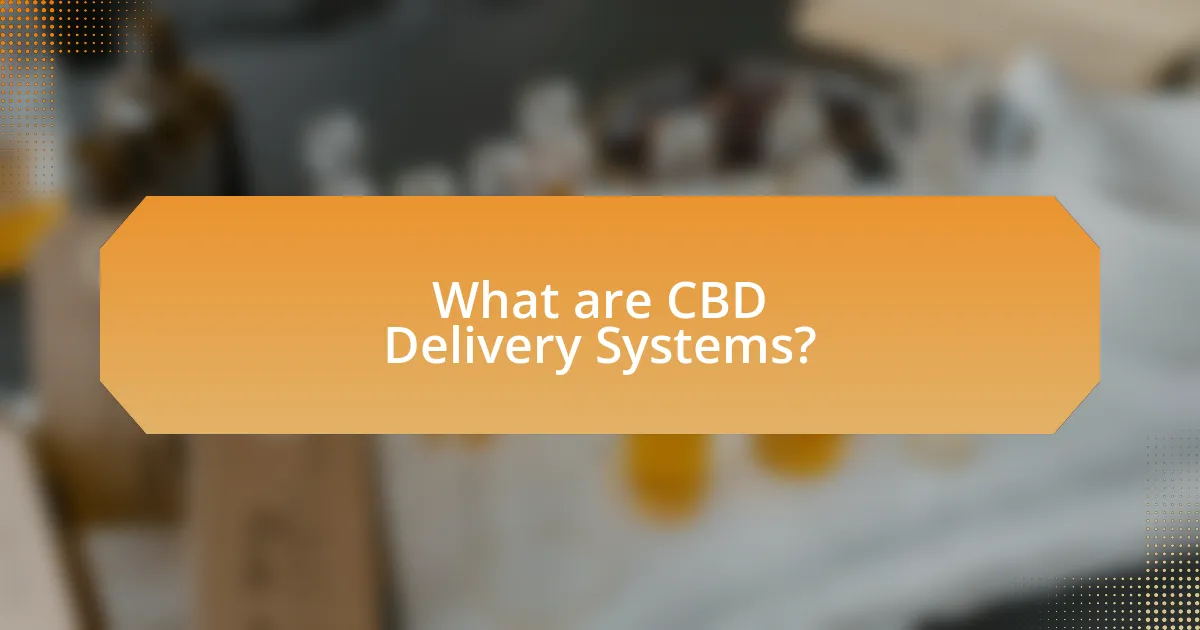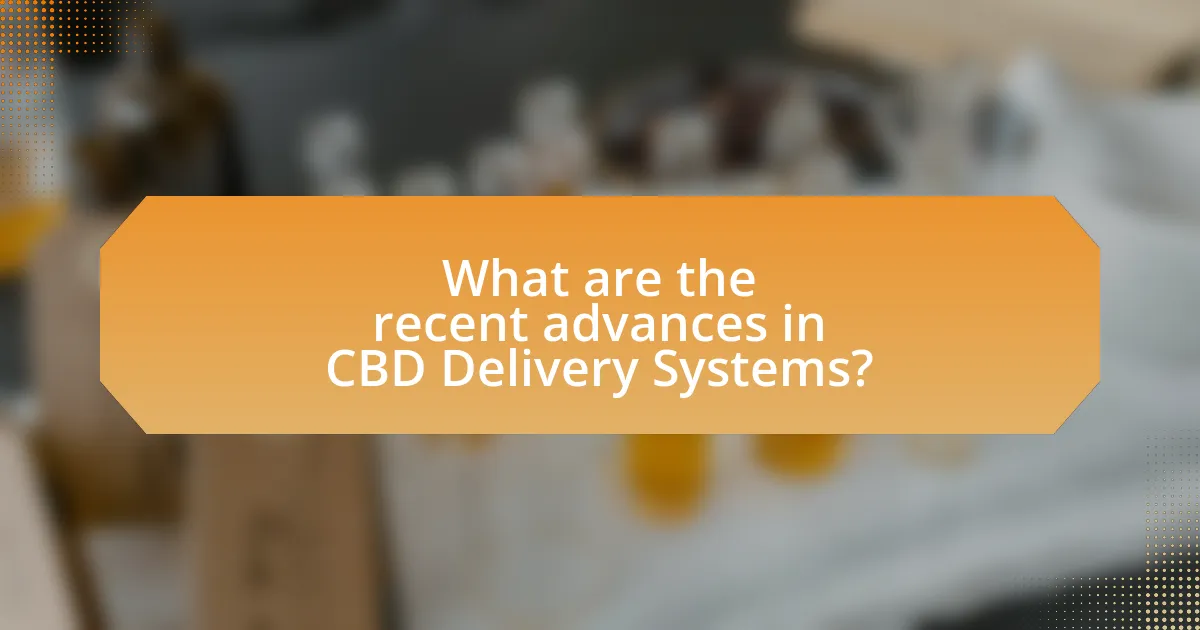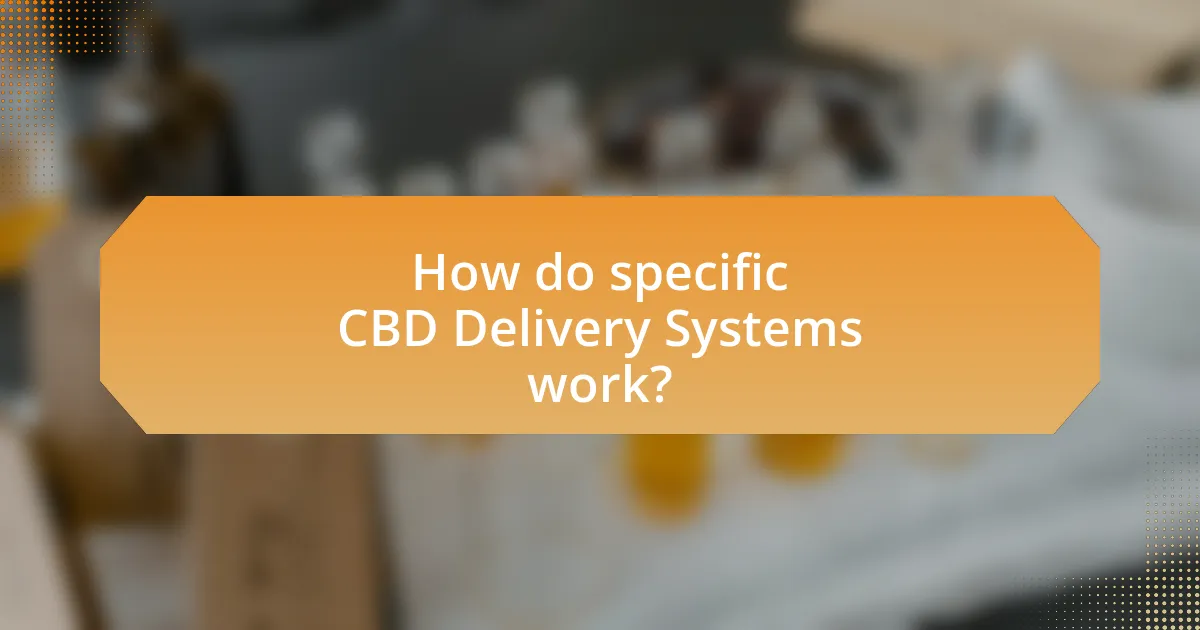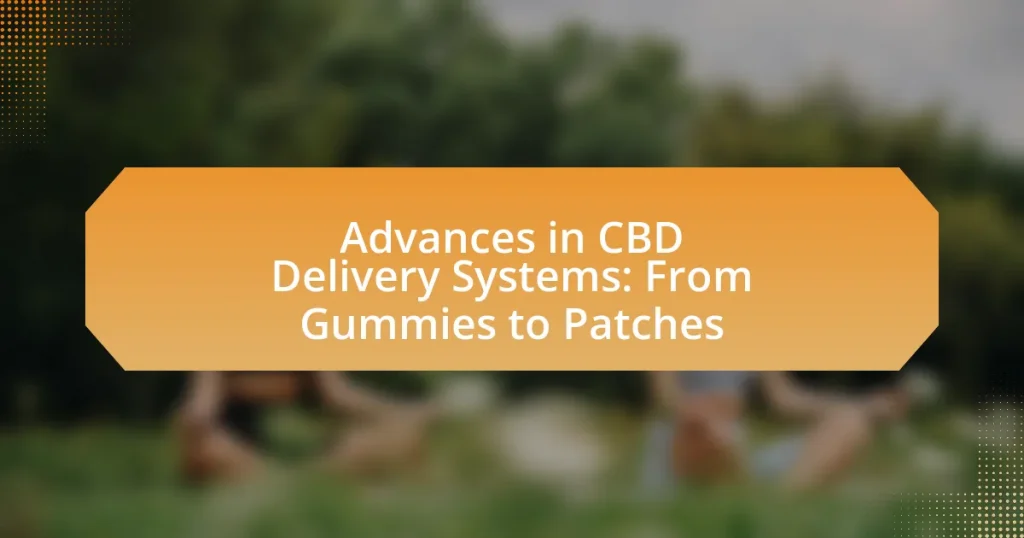Advances in CBD delivery systems encompass a range of innovative methods for administering cannabidiol, including oils, tinctures, capsules, edibles, topicals, and transdermal patches. These systems are designed to optimize bioavailability and absorption, with recent developments such as nanotechnology and enhanced formulations improving the effectiveness of CBD products. The article explores how different delivery methods function, their bioavailability rates, and the impact of consumer preferences on product development. Additionally, it highlights the benefits of modern delivery systems, emerging trends, and practical considerations for consumers when selecting CBD products.

What are CBD Delivery Systems?
CBD delivery systems are methods used to administer cannabidiol (CBD) to the body, ensuring effective absorption and therapeutic effects. These systems include various forms such as oils, tinctures, capsules, edibles, topicals, and transdermal patches, each designed to optimize the bioavailability of CBD. For instance, transdermal patches allow for sustained release of CBD through the skin, providing prolonged effects, while edibles like gummies offer a convenient and palatable option for consumption. The effectiveness of these delivery systems is supported by studies indicating that different methods can influence the onset and duration of CBD’s effects, highlighting the importance of selecting the appropriate delivery system for individual needs.
How do CBD Delivery Systems function?
CBD delivery systems function by utilizing various methods to transport cannabidiol into the body, ensuring effective absorption and bioavailability. These systems include oral forms like gummies and capsules, which dissolve in the digestive tract, and transdermal patches that allow CBD to penetrate the skin directly into the bloodstream. Research indicates that transdermal delivery can enhance bioavailability compared to oral ingestion, as it bypasses the first-pass metabolism in the liver, leading to more efficient absorption. Studies have shown that transdermal patches can deliver consistent doses over extended periods, making them a reliable option for users seeking sustained effects.
What are the key components of CBD Delivery Systems?
The key components of CBD delivery systems include formulation, absorption method, and bioavailability. Formulation refers to the specific combination of ingredients used to create the CBD product, such as oils, emulsifiers, and flavorings, which can affect the stability and effectiveness of the CBD. Absorption method encompasses the various ways CBD can enter the body, including oral, transdermal, inhalation, and sublingual routes, each offering different onset times and effects. Bioavailability is the measure of how much CBD reaches systemic circulation and can be utilized by the body, which varies significantly across different delivery methods; for instance, sublingual delivery typically offers higher bioavailability compared to oral ingestion due to bypassing the digestive system.
How do these components influence the effectiveness of CBD delivery?
The components of CBD delivery systems, such as formulation, method of administration, and bioavailability, significantly influence the effectiveness of CBD delivery. For instance, the formulation determines how well CBD is absorbed in the body; liposomal formulations enhance bioavailability by encapsulating CBD in lipid layers, which improves absorption rates. Additionally, the method of administration, whether through gummies, oils, or transdermal patches, affects the onset and duration of effects; for example, transdermal patches provide a steady release of CBD over time, leading to prolonged effects. Research indicates that bioavailability can vary widely; for example, oral ingestion of CBD has a bioavailability of approximately 6-20%, while sublingual administration can reach up to 35%. These factors collectively dictate how effectively CBD interacts with the endocannabinoid system, ultimately influencing therapeutic outcomes.
What types of CBD Delivery Systems are available?
Various types of CBD delivery systems are available, including oils, tinctures, capsules, edibles, topicals, and vape products. Oils and tinctures are liquid forms that allow for sublingual absorption, providing quick effects. Capsules offer a convenient, pre-measured dose, while edibles, such as gummies, provide a tasty option with longer onset times. Topicals, like creams and balms, are applied directly to the skin for localized relief. Vaping delivers CBD rapidly through inhalation, offering immediate effects. Each delivery system has unique absorption rates and effects, catering to different user preferences and needs.
What are the most common forms of CBD delivery?
The most common forms of CBD delivery include oils, tinctures, edibles, capsules, topicals, and vape products. Oils and tinctures are popular for their quick absorption and ease of use, allowing users to measure precise dosages. Edibles, such as gummies, offer a convenient and tasty way to consume CBD, while capsules provide a familiar method similar to traditional supplements. Topicals, including creams and balms, are applied directly to the skin for localized relief. Vaping allows for rapid onset of effects, making it a preferred choice for some users. These delivery methods cater to diverse preferences and needs, enhancing accessibility to CBD products.
How do different delivery methods compare in terms of bioavailability?
Different delivery methods for CBD exhibit varying levels of bioavailability, which refers to the proportion of the active compound that enters the bloodstream when introduced into the body. For instance, sublingual delivery methods, such as tinctures, typically offer higher bioavailability (up to 35%) compared to oral methods like gummies, which may have a bioavailability of around 4-20% due to first-pass metabolism in the liver. Transdermal patches can provide a steady release of CBD and achieve bioavailability rates of approximately 10-15%, while inhalation methods, such as vaping, can reach bioavailability levels of 30-50% due to direct absorption into the bloodstream through the lungs. These differences highlight the importance of selecting an appropriate delivery method based on desired effects and efficiency.

What are the recent advances in CBD Delivery Systems?
Recent advances in CBD delivery systems include the development of nanotechnology-based formulations, transdermal patches, and enhanced bioavailability methods. Nanotechnology allows for the creation of nanoemulsions that improve the solubility and absorption of CBD, leading to faster onset of effects. Transdermal patches provide a convenient and controlled release of CBD, allowing for sustained effects over time. Enhanced bioavailability methods, such as liposomal encapsulation, significantly increase the amount of CBD that enters the bloodstream, making these delivery systems more effective. These innovations are supported by studies demonstrating improved absorption rates and therapeutic outcomes compared to traditional methods.
How have innovations improved CBD delivery methods?
Innovations have significantly improved CBD delivery methods by introducing advanced formulations and technologies that enhance bioavailability and user experience. For instance, nanotechnology has enabled the creation of nanoemulsions, which increase the absorption rate of CBD in the body, allowing for faster onset of effects compared to traditional oil-based products. Additionally, transdermal patches have emerged as a novel delivery system, providing a consistent release of CBD over time and bypassing the digestive system, which can degrade the compound. Research indicates that these methods can improve the effectiveness of CBD, with studies showing that nanoemulsified CBD can achieve up to 90% bioavailability, compared to only 6-15% for conventional oils.
What role does technology play in enhancing CBD delivery systems?
Technology significantly enhances CBD delivery systems by improving bioavailability and precision in dosing. Advanced methods such as nanoemulsion and liposomal encapsulation increase the absorption rate of CBD in the body, allowing for more effective therapeutic outcomes. For instance, studies have shown that nanoemulsified CBD can achieve up to 90% bioavailability compared to traditional oil-based formulations, which typically range around 6-10%. Additionally, innovations like transdermal patches utilize microneedle technology to deliver CBD directly into the bloodstream, bypassing the digestive system and enhancing the speed of onset. These technological advancements not only optimize the efficacy of CBD products but also cater to consumer preferences for convenience and targeted relief.
How have consumer preferences influenced these advancements?
Consumer preferences have significantly influenced advancements in CBD delivery systems by driving demand for more convenient, effective, and diverse product formats. As consumers increasingly seek alternatives to traditional methods, such as smoking or oils, the popularity of edibles like gummies and innovative options like transdermal patches has surged. Market research indicates that the global CBD edibles market is projected to reach $4.1 billion by 2025, reflecting a clear consumer shift towards these formats. This shift has prompted manufacturers to invest in research and development to enhance bioavailability and user experience, leading to the creation of products that cater to specific consumer needs, such as faster onset times and discreet usage.
What are the benefits of modern CBD Delivery Systems?
Modern CBD delivery systems offer enhanced bioavailability, allowing for more efficient absorption of cannabidiol into the bloodstream. This increased bioavailability is achieved through innovative methods such as nanoemulsion and transdermal patches, which facilitate quicker onset of effects compared to traditional methods like oils or edibles. For instance, studies have shown that transdermal delivery can bypass the digestive system, leading to a more direct and potent effect, which is particularly beneficial for individuals seeking rapid relief from conditions such as pain or anxiety. Additionally, modern delivery systems provide precise dosing, improved convenience, and longer-lasting effects, making them more user-friendly and effective for consumers.
How do these systems improve user experience?
These systems improve user experience by providing more efficient and targeted delivery of CBD, which enhances the effectiveness of the product. For instance, transdermal patches allow for a steady release of CBD over time, leading to prolonged effects without the need for frequent dosing. Research indicates that this method can increase bioavailability, meaning more of the active ingredient reaches the bloodstream compared to traditional methods like gummies. Additionally, the convenience and discretion of patches or other advanced delivery systems cater to user preferences, making it easier for individuals to incorporate CBD into their daily routines.
What health benefits are associated with advanced CBD delivery methods?
Advanced CBD delivery methods, such as transdermal patches and nanoemulsions, offer enhanced bioavailability and faster onset of effects compared to traditional methods. These delivery systems improve the absorption of CBD into the bloodstream, allowing for more effective management of conditions like chronic pain, anxiety, and inflammation. Research indicates that transdermal patches can provide sustained release and prolonged effects, making them suitable for long-term relief. Additionally, nanoemulsions can increase the solubility of CBD, leading to higher plasma concentrations and improved therapeutic outcomes.

How do specific CBD Delivery Systems work?
Specific CBD delivery systems work by utilizing various methods to introduce cannabidiol into the body, ensuring effective absorption and targeted effects. For instance, sublingual delivery systems, such as oils and tinctures, allow CBD to be absorbed directly into the bloodstream through the mucous membranes under the tongue, providing rapid onset of effects. Edibles, like gummies, undergo digestion before CBD enters the bloodstream, resulting in a slower onset but prolonged effects. Transdermal patches deliver CBD through the skin, allowing for a steady release over time and bypassing the digestive system, which can enhance bioavailability. Each delivery system is designed to optimize the absorption and efficacy of CBD, catering to different user preferences and therapeutic needs.
What are the characteristics of CBD Gummies?
CBD gummies are edible candies infused with cannabidiol, a non-psychoactive compound derived from the cannabis plant. These gummies typically exhibit characteristics such as precise dosage, which allows users to easily manage their intake, and a variety of flavors and shapes that enhance palatability. Additionally, CBD gummies are often made with natural ingredients and may be vegan or gluten-free, catering to diverse dietary preferences. The bioavailability of CBD in gummy form can vary, but it generally provides a convenient and discreet method of consumption, making it appealing for both new and experienced users.
How do CBD Gummies differ from traditional edibles?
CBD gummies differ from traditional edibles primarily in their formulation and purpose. While traditional edibles, such as baked goods or candies, may contain various ingredients and flavors without a specific focus on cannabinoid content, CBD gummies are specifically designed to deliver a precise dosage of cannabidiol. This targeted formulation allows for consistent dosing, as each gummy typically contains a standardized amount of CBD, making it easier for users to manage their intake. Additionally, CBD gummies often incorporate other beneficial ingredients, such as vitamins or natural flavors, enhancing their appeal and potential health benefits.
What are the advantages of using CBD Gummies for delivery?
CBD gummies offer several advantages for delivery, primarily their convenience, precise dosing, and palatable taste. The convenience of gummies allows for easy transport and discreet consumption, making them suitable for on-the-go use. Precise dosing is achieved as each gummy typically contains a specific amount of CBD, allowing users to manage their intake effectively. Additionally, the taste of gummies can mask the natural flavor of CBD, making them more enjoyable for users who may be sensitive to the taste of other forms of CBD. These factors contribute to the growing popularity of CBD gummies as a preferred delivery method.
What are the features of CBD Patches?
CBD patches are transdermal delivery systems designed to provide a steady release of cannabidiol into the bloodstream through the skin. These patches typically feature a controlled dosage mechanism, allowing for consistent absorption over an extended period, often lasting up to 24 hours. The adhesive backing ensures that the patch remains securely in place, while the formulation may include additional ingredients to enhance skin penetration and bioavailability. Studies indicate that transdermal delivery can bypass the digestive system, potentially increasing the effectiveness of CBD compared to oral methods.
How do CBD Patches provide sustained release of cannabinoids?
CBD patches provide sustained release of cannabinoids through a transdermal delivery system that allows cannabinoids to be absorbed directly into the bloodstream over an extended period. This method utilizes a combination of permeation enhancers and a controlled-release matrix, which ensures a gradual release of CBD, maintaining therapeutic levels in the body for several hours or even days. Studies have shown that transdermal patches can deliver cannabinoids effectively, bypassing the digestive system and liver metabolism, which can degrade the compounds and reduce their efficacy.
What are the potential benefits of using CBD Patches over other methods?
CBD patches offer several potential benefits over other methods of CBD delivery, including consistent dosing, prolonged effects, and ease of use. Unlike oral methods, which can be affected by digestive processes, patches deliver CBD directly through the skin into the bloodstream, ensuring a more stable and predictable absorption rate. This transdermal delivery system can provide effects that last for several hours, often longer than edibles or tinctures, which may require more frequent dosing. Additionally, patches are discreet and convenient, allowing users to apply them without the need for measuring doses or carrying additional products.
What are the emerging trends in CBD Delivery Systems?
Emerging trends in CBD delivery systems include the development of nanotechnology-based formulations, transdermal patches, and water-soluble CBD products. Nanotechnology enhances bioavailability by reducing particle size, allowing for faster absorption and more effective delivery of CBD into the bloodstream. Transdermal patches provide a convenient and sustained release of CBD, offering a non-invasive method for users to experience its effects over an extended period. Water-soluble CBD products, which mix easily with liquids, are gaining popularity due to their improved absorption rates compared to traditional oil-based formulations. These trends reflect a growing emphasis on efficiency and user convenience in the CBD market.
How are new formulations changing the landscape of CBD delivery?
New formulations are significantly transforming the landscape of CBD delivery by enhancing bioavailability and user experience. Innovations such as nanoemulsions and liposomal encapsulation improve the absorption of CBD into the bloodstream, allowing for faster onset of effects and more efficient dosing. For instance, studies indicate that nanoemulsified CBD can increase bioavailability by up to 200% compared to traditional oil-based formulations. Additionally, the development of transdermal patches offers a discreet and sustained release method, providing consistent dosing over extended periods. These advancements not only cater to diverse consumer preferences but also expand the therapeutic potential of CBD by ensuring more effective delivery mechanisms.
What future innovations can we expect in CBD delivery technology?
Future innovations in CBD delivery technology are expected to include nanotechnology-based formulations, which enhance bioavailability and absorption rates. Research indicates that utilizing nanoparticles can significantly improve the effectiveness of CBD by allowing for more precise targeting within the body. Additionally, advancements in transdermal patches are anticipated, enabling sustained release and improved user compliance. Studies have shown that these patches can deliver consistent doses over extended periods, making them a promising option for chronic pain management. Furthermore, the integration of smart technology, such as dosage tracking and personalized delivery systems, is likely to emerge, providing users with tailored experiences based on their specific needs and responses.
What practical tips should consumers consider when choosing CBD Delivery Systems?
Consumers should consider the bioavailability, onset time, and personal preferences when choosing CBD delivery systems. Bioavailability refers to the proportion of CBD that enters the bloodstream when introduced into the body, which varies significantly among delivery methods; for instance, sublingual oils typically have higher bioavailability than edibles. Onset time is crucial as it determines how quickly the effects of CBD are felt; inhalation methods provide rapid effects, while edibles may take longer to produce results. Additionally, consumers should assess their lifestyle and comfort with different forms, such as oils, capsules, or topical applications, to ensure the chosen method aligns with their daily routine and preferences.



